Winter Audio Reference: On-Board, Consumer, and Pro Solutions
by Derek Wilson on February 3, 2005 12:05 AM EST- Posted in
- Smartphones
- Mobile
Gaming Performance Tests
As game frame rates in modern systems are not heavily impacted by various audio settings, one of the best measures of "goodness" for games will be simply the maximum number and type of hardware buffers that the card supports. Beyond that, the RightMark 3DSound synthetic test can give an indication of what CPU usage will be like in gaming situations. Listed below are the number and type of hardware buffers that each card supports:
Intel HD Audio: 32 buffers 2D, 3D, EAX 2
Gina3G: 128 buffers 2D only
SoundBlaster Audigy 2 ZS PPro: 62 buffers 2D, 3D, EAX 4 Advanced HD
SoundBlaster Audigy 4 Pro: 62 buffers 2D, 3D, EAX 4 Advanced HD
The fact that the Gina3G can open over twice as many DirectSound buffers as the Audigy gives it an advantage in its ability to push audio. But the target is definitely more of a home studio multi-track editing environment rather than a gaming environment. The Gina3G's lack of any 3D accelerated buffer support does make it less of a gaming audio card, as is to be expected. While the Realtek Intel solution provides EAX 2, it's able to provide adequate support for most games on the market.
There are titles out with support for EAX 3 and 4, and they do sound good. Games like Thief 3 and The Chronicles of Riddick make good use of audio to help the gamer actually play the game. Understanding an environment is becoming truly necessary in modern gaming. But we would prefer to see unique personal innovation or the adoption of open standards rather than consumption of proprietary technology.
The RightMark test simulates some normal positional audio effects and internally checks CPU usage every half second. Overall, CPU usage is averaged together at the end of the run. This is the number that we will look at here. Our graphs are broken into multiple series for 16 and 32 buffers, and we've done graphs for the "no audio" case, simple stereo, hardware 3D, and hardware 3D + EAX. Positional audio, in this case, is done via DirectX.
In our tests, we see the Audigy 2 outperforming the Audigy 4 in our DS3D and EAX tests. The Intel solution puts in a good showing as well, though Creative naturally does EAX better. In the 2D realm, the Gina3G doesn't do too poorly either. Note also, that we are talking about percent CPU usage here, so a score of 0.1 is 0.1% of the CPU. The heaviest hitting test comes in at under 5% CPU usage, which just goes to show how little impact even our least efficient HW 3D + EAX implementation has on overall game performance.
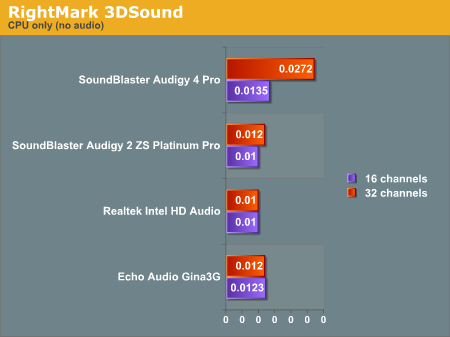
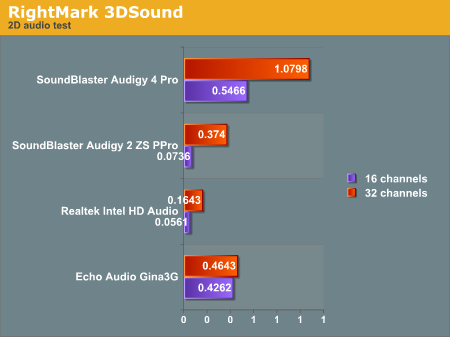
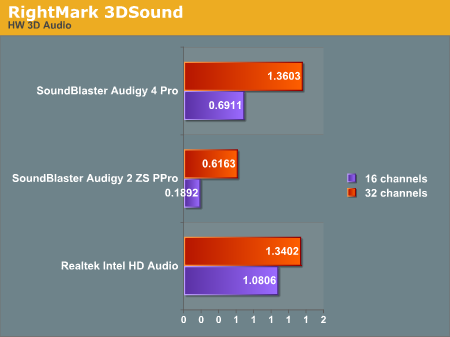
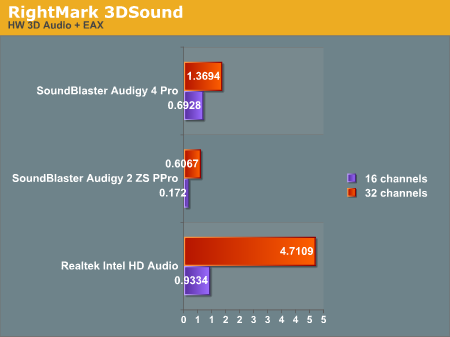
To round out our gaming performance analysis, we'll take a look at Unreal Tournament 2004. All the in-game graphics details were set to "normal" and resolution was set to 800x600. Higher settings pushed the rest of the system too high and drowned out the effect of the audio (as the graphics card became the limiting factor rather than the CPU). Call this artificial if you like, but showing that it takes this much to get a performance delta out of enabling audio is a useful test in and of itself. Especially considering the fact that these differences are bigger than what we saw with Doom 3 no matter what we did.
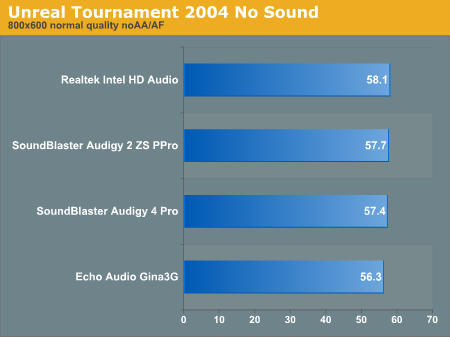
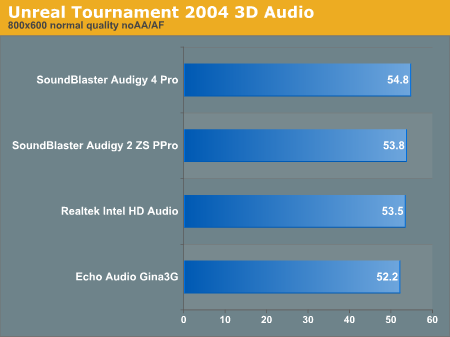
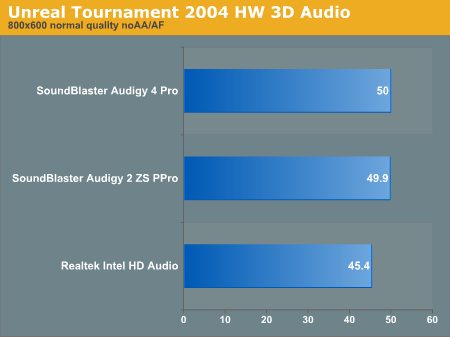
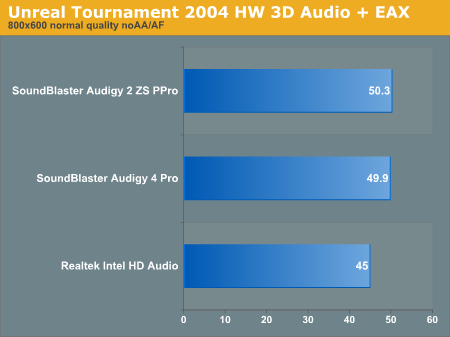










89 Comments
View All Comments
DerekWilson - Thursday, February 3, 2005 - link
Sorry for the confusion guys,We had originally just picked on card from each end of the market (onboard, addin, pro) and then decided that we needed to do both the audigy 2 and 4 because they're so similar. It's really meant to be an intro piece on sound and a look at an example of each market segment.
We certainly weren't trying to be all inclusive, and we do want your feedback. These cards will be our "comparison point" cards in each market segment. When we look at onboards solutions, we'll talk about how it compares to the ALC880, and on the Pro side, we'll match up the Gina3G with whatever we're looking at.
And when we do a targeted review as for proaudio we will absolutely spend time setting up a workstation and running some latency tests and we'll talk about asio/gsif support more in depth.
We will be reviewing more sound cards :-)
We didn't want to review all of them at once and spoil the fun though. :-D
MarkM - Thursday, February 3, 2005 - link
I second #5's request -- esp concerning the onboard, which is more relevant for most new builds>on board nvidia audio would be interesting as well as an older sb live 5.1 card for reference
LoneWolf15 - Thursday, February 3, 2005 - link
Not a single card based on the VIA Envy24 setup...no M-Audio Revolution, no Terratec, no Chaintech AV-710 (all Envy24-based)...I can't believe Anandtech left one of the largest enthusiast chipsets out of the roundup. There's just not enough representation here of available solutions to make a good comparison, it's either Intel or Creative, and Intel isn't an option for AMD users.If you're going to make onboard comparisons, why not (even if it's a poor solution) add the ALC850 found on most Socket 754/939 boards, seeing as AMD users can't exactly get Intel/Azalia HD audio?
hondaman - Thursday, February 3, 2005 - link
More cards please!!! Soundstorm, older audigy/Live and m-audio sure would have made this article a whole lot better, as thats what a lot of people are using.bob661 - Thursday, February 3, 2005 - link
If mid-range cards are an order of magnitude better in objective sound tests than onboard solutions, I might actually go back to buying sound cards.I would like to reaquest testing the onboard Realtek's on the Athlon64 motherboards. I would be interested in seeing how they perform compared to mid-range and high-end sound cards.
EddNog - Thursday, February 3, 2005 - link
Yep; gotta' have at least a halfway decent setup, from head to tail. I'm pretty happy with my setup:foobar2000 kernel streaming FLAC/Monkey's Audio to
Echo Audio Mia MIDI with sample rate locked to 44.1, out via 75ohm impedance silver coax S/PDIF to
Onkyo TX-SR501, out via silver cabling to
a pair of Paradigm Studio/20 Rev. 3 sitting on
Atlantis Reference stands
"I'm lovin' it."
-Ed
OrSin - Thursday, February 3, 2005 - link
Most people are not gaming with 800 sound cards.I would be suprised if gamers are using $100 sound cards. When people list out thier RIGS 8 out 10 don't even lsit thier sound card. And the other 2 have $100 or less cards. I'm all for a review of $200+ cards but almost all are not using them for gaming.
Also in order to hear better sound from $100+ card you need a better and better speak system. Not just speaker, but a good in home setup. I threw down $1000 on a speak system and it sound ok. WhenI had my friend come over and setup it up right. It sounded great. It more then just buying them and plugging them in. It take a lot to get a quailty setup. High end sound cards only will not do it, so for some it just not worth going beyond a $100 card.
Araemo - Thursday, February 3, 2005 - link
[Self-serving]Could we get an onboard audio review for the Soundstorm on the Abit NF7-S v2? ;P[/self-serving]
Seriously though, good review.. but I'd like to know where my current system stands.
And does anybody know how much "THX Certified" is worth? I have logitech Z-2200s connected to my nForce onboard right now(My Audigy developed an odd crackling noise during gameplay that I couldn't get rid of.)
yodel - Thursday, February 3, 2005 - link
YellowWing - Thursday, February 3, 2005 - link
What about AC3 digital encode? The next PC I build will be a HTPC, and digital encode for a single connection to my receiver is of great importance. I doubt if any of the sound systems analog sections would be used.What is the overhead of the digital encode? Does it slow a frame rate or not seem to matter?
Can you hear the difference between the digital and analog output with a good home theater setup?